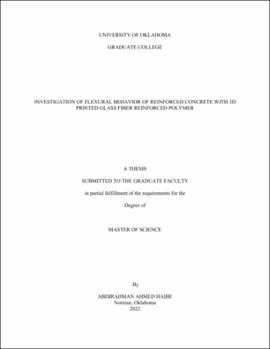| dc.description.abstract | More than 40 years of Fiber Reinforced Polymers in Civil Engineering has shown the widespread use and advantages of these unique composites. FRP composites are high strength, lightweight, corrosion resistant materials that are known for their long-term durability and performance in infrastructure applications. FRP composites are available in the form of sheets, rods, grids and winding strands that are used for a wide range of civil engineering applications. In the last decade, 3D printing technology for manufacturing FRP composites for construction applications has gained increased attention. With 3D printing technology, FRP composites can be printed with radical shapes and properties resulting in varied mechanical performances. Precise angles, optimized designs and radical shapes are also some of the several advantages that 3D printed FRP composites can offer. With increasing demand for 3D printed composites and with interest in using these composites for construction applications, it is very important to understand the behavior of these composites in concrete when used as reinforcement. Concrete - FRP bond behavior plays a significant role in controlling debonding failures in FRP-strengthened flexural elements ultimately contributing to their structural performance. In addition, compared to conventional Portland cement-based concrete, polymers in concrete can have a much different behavior due to better engagement with increased bond strength with the constituents. Polymers have known to have higher bond strength with other materials compared to cement due to lack of saturation in the latter. Therefore, the behavior of FRP, especially 3D printed FRP may be different in these different concretes. This work investigates the flexural behavior, failure modes and ductility of conventional FRP composites, conventionally manufactured and 3D printed, used as a reinforcement in concrete. Two types of concrete are investigated for understanding the flexural response of FRP composites. A Methyl Methacrylate based polymer concrete and Portland cement-based concrete reinforced with Glass FRP reinforcement. The results of this work show that both conventional and 3D printed FRP composites used as reinforcements in Portland cement concrete and Polymer concrete improve the moment capacity and flexural capacity of the beams. However, on average, 3D printed GFRP in Polymer concrete has improved flexural response than the 3D printed GFRP in Portland cement concrete. Microscopic analysis was conducted to observe damage in all the beams subjected to flexural testing. These investigations indicated that polymer concrete shows better engagement with the reinforcement.
The outcomes of this work show that 3D printed FRP composites are suitable for use in construction applications. Further understanding of the behaviors of 3D printed FRP composites in concrete lead a way to advanced concrete based reinforced composites that can be 3D printed in radical shapes and designed for tailored mechanical properties and performance for construction applications. | en_US |
